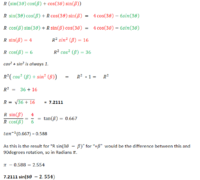Chris_inkubate
New member
- Joined
- Jul 2, 2020
- Messages
- 4
Hi there,
I am working on a submission which asks the following question:
The third harmonic of a sound wave is given by;
4cos(3?) − 6sin(3?)
Express this sound wave in the form;
? sin(3?+?)
I managed to work out R without any huge problems. However working out ? has been an issue. I managed to find a value that worked but only by getting the result of (3?-?) and using some intuition of radians that pi minus this value would be the difference and work. It appears to have worked on this occasion but I feel I have fudged it a little to get this and expect there is a better way. Any assistance would be much appreciated to improve my workings. Many thanks.

I am working on a submission which asks the following question:
The third harmonic of a sound wave is given by;
4cos(3?) − 6sin(3?)
Express this sound wave in the form;
? sin(3?+?)
I managed to work out R without any huge problems. However working out ? has been an issue. I managed to find a value that worked but only by getting the result of (3?-?) and using some intuition of radians that pi minus this value would be the difference and work. It appears to have worked on this occasion but I feel I have fudged it a little to get this and expect there is a better way. Any assistance would be much appreciated to improve my workings. Many thanks.

